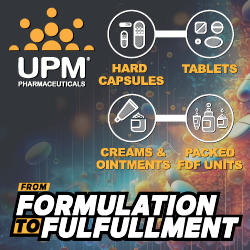Benefits of Small-Scale Drug Development
 By: Kieran Coffey, Technical Lead at Pfizer CentreOne’s Newbridge Facility
By: Kieran Coffey, Technical Lead at Pfizer CentreOne’s Newbridge Facility
Whether progressing from bench-scale formulation development or assessing the influence of an ingredient change on product performance, the ability to produce trial batches at an appropriate intermediate scale is critical to establishing robustness of manufacture at large scale. Here, Kieran Coffey, Technical Lead at Pfizer CentreOne’s Newbridge facility, discusses the benefits of small-scale processing for process development of tablet products.
WHY SMALL-SCALE PROCESS DEVELOPMENT?
Drug developers may have concerns about using small scale processing to represent commercial scale manufacturing. These include the possibility of materials behaving differently at different scales and some operations being particularly difficult to scale-up. However, having access to small-scale process capability which simulates larger scale processes offers many benefits, such as:
- Materials usage is minimised and the cost of batch manufacture is reduced compared with trials at large scale.
- Challenges associated with access to commercial-scale equipment (eg, scheduling, resource management) are avoided.
- Smaller scale equipment allows for greater flexibility in reacting to and rectifying processing issues.
- If challenges occur during manufacturing trials they can be investigated without the time pressure of having to hand back equipment for routine product manufacture.
FACTORS TO CONSIDER DURING SMALL-SCALE PROCESS DEVELOPMENT
The risk of process failure when scaling up for commercial batches can be mitigated by consideraing established guiding principles. These recommended approaches for replicating commercial processes during small- scale development are addressed below.
Blending
Maintaining geometric similarity for mixing vessels is advised for the scaling of blending operations, for powders, and liquids (Figure 1).

Figure 1. Maintaining geometric similarity on scale-up is recommended for blending.
It is important to consider the mechanics involved during blending (eg, distance travelled by particles, forces applied, etc) and to match the mechanics at all scales. Fundamental “rules of thumb” for blending at different scales are:
- Maintain the same number of rotations.
- Keep fill volumes constant across scales.
- Reduce rotational speed as bin size increases.
Another approach is to use a colored ingredient to assess uniformity of blend and mixing efficiency at different scales, as described by Barling.1 Modern process development uses PAT technology, particularly NIR spectroscopy, to confirm blend uniformity for every batch without the requirement for laboratory testing. The models can be built and developed at small scale and then scaled up to commercial operations.
Granulation
Scale change for dry granulation operations (ie, powder blending followed by roller compaction) is relatively straightforward. Roller compaction can be considered a continuous process and therefore for different scales of manufacture, it is simply a case of roller compacting for shorter or longer periods of time depending upon the quantity of granule mass required. Scale change for wet granulation operations can be more challenging. As for powder blending, maintaining geometric similarity for granulation equipment is recommended. In addition, “power number” correlation can be used when changing scale for high-shear granulation operations. There are different equations that can be used for this purpose (eg, Froude, Newton, Reynolds), but in each case, the basic principle is the same. A dimensionless number is calculated based on specific process parameters, and this number is maintained for scale change. The Froude number equation is the most popular for scale change of high-shear granulation (Figure 2), and its use for this purpose is described by Horsthius.2

Figure 2. Use of Froude number for scale change in high-shear granulation.
An alternative approach, and most often used in the industry, is that described by Rehki and summarised below: 3
- Maintain a constant impeller tip speed across all scales.
- Maintain granulating liquid volume proportional to batch size.
- Wet massing time inversely proportional to impeller rotational speed (rpm).
Further useful reviews of scale-up methodologies for granulation are provided by Jang4, Faure5, and Tao.6
Compression
For scale change in tablet compression, it is important to consider the fundamental mechanics involved in powder compaction and to simulate the forces involved at the different scale.
The factors to be addressed for tablet compression scale change are:
- Dwell time
- Contact time
- Consolidation time
- Relaxation time
- Powder flow into die
- Punch speed
The main process parameters that can be studied to achieve the desired output are press speed and feeder. The use of compaction simulation to perform tablet compression using different compaction parameters (and simulate compression characteristics of different types of tablet press) can be extremely useful and material requirements are minimal for conducting trials.
Guidelines on tablet compression development, optimization, and scale-up are provided by Natoli.7
Coating
Pan coating is the most common process used for coating tablets. A schematic representation of the pan coating process is shown in Figure 3.

Figure 3. Schematic illustrating the pan coating process for tablet coating. (Click image to enlarge)
Factors that need to be taken into consideration in scale-up fall into three categories: pan‐related, spray‐related, and thermodynamic‐related. Fundamentally, a coating operation consists of balancing the mass and energy entering the pan against the mass and energy leaving the pan. An understanding of these dynamics is important in assessing influence of scale change on operational parameters (eg, drum rotational speed and spray rate) – and the potential impact on quality of coating. A useful thermodynamic model for tablet coating is provided by am Ende.8
CONCLUSION
The scale-up of pharmaceutical manufacturing operations can be challenging and involves risk. However, small-scale process development, using appropriate equipment and applying well established guiding principles, mitigates risk using a material-sparing and resource efficient approach.
REFERENCES
- Barling, D., et al. Pharmaceutical dry powder blending and scale-up: Maintaining equivalent mixing conditions using a coloured tracer powder. Powder Technol (2015), 270: 461-469.
- Horsthuis G.J.B., et al. Studies on upscaling parameters of the Gral high shear granulation process. Int J Pharm (1993), 92(1-3): 143-150.
- Rehki, G.S., et al. A new approach to scale-up of a high-shear granulation process. Pharm Technol (Oct. 1996), 20(10): 2-10.
- Jang, E.H., et al. Model-based scale-up methodologies for pharmaceutical granulation. Pharmaceutics (2020), 12(5): 453.
- Faure, A., et al. Process control and scale-up of pharmaceutical wet granulation processes: a review. Eur J Pharm Biopharm (2001), 52: 269-277.
- Tao, et al. Evaluating scale-up rules of a high-shear wet granulation process. J Pharm Sci (2015), 104(7): 2323-2333.
- Natoli, D., et al. Development, optimization and scale-up of process parameters: Tablet compression. Developing Solid Oral Dosage Forms: Pharmaceutical Theory and Practice, Elsevier, Inc. (2009), Chapter 32: 725-759.
- am Ende, M.T. and Berchielli, A. A thermodynamic model for organic and aqueous tablet film coating. Pharm Dev Technol (2005), 1: 47-58.
Total Page Views: 4636













